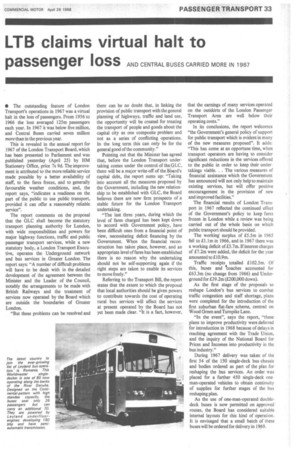LTB claims virtual halt to
Page 35

If you've noticed an error in this article please click here to report it so we can fix it.
passenger loss AND CENTRAL BUSES CARRIED MORE IN 1967 • The outstanding feature of London Transport's operations in 1967 was a virtual halt in the loss of passengers. From 1956 to 1966 the loss averaged 125m passengers each year. In 1967 it was below five million, and Central Buses carried seven million more than in the previous year.
This is revealed in the annual report for 1967 of the London Transport Board, which has been presented to Parliament and was published yesterday (April 25) by HM Stationery Office, price 7s 9d. The improvement is attributed to the more reliable service made possible by a better availability of staff, to the fares freeze, and to generally favourable weather conditions, and, the report says, "indicates a readiness on the part of the public to use public transport, provided it can offer a reasonably reliable service".
The report comments on the proposal that the GLC shall become the statutory transport planning authority for London, with wide responsibilities and powers for major highway functions, traffic and public passenger transport services, while a new statutory body, a London Transport Executive, operates the Underground network and bus services in Greater London. The report says: "A number of difficult problems will have to be dealt with in the detailed development of the agreement between the Minister and the Leader of the Council, notably the arrangements to be made with British Railways and the treatment of services now operated by the Board which are outside the boundaries of Greater London.
"But these problems can be resolved and there can be no doubt that, in linking the provision of public transport with the general planning of highways, traffic and land use, the opportunity will be created for treating the transport of people and goods about the capital city as one composite problem and not as a series of conflicting operations. In the long term this can only be for the general good of the community."
Pointing out that the Minister has agreed that, before the London Transport undertaking comes under the control of the GLC, there will be a major write-off of the Board's capital debt, the report sums up: "Taking into account all the measures proposed by the Government, including the new relationship to be established with GLC, the Board believes there are now firm prospects of a stable future for the London Transport undertaking.
"The last three years, during which the level of fares charged has been kept down to accord with Government policy,, have been difficult ones from a financial point of view, necessitating deficit financing by the Government. When the financial reconstruction has taken place, however, and an appropriate level of fares has been established there is no reason why the undertaking should not be self-supporting again if the right steps are taken to enable its services to move freely."
Referring to the Transport Bill, the report states that the extent to which the proposal that local authorities should be given powers to contribute towards the cost of operating rural bus services will affect the services at present operated by the Board has not yet been made clear. "It is a fact, however, that the earnings of many services operated on the outskirts of the London Passenger Transport Area are well below their operating costs."
In its conclusions, the report welcomes "the Government's general policy of support
for public transport which is evident in many of the new measures proposed". It adds: "This has come at an opportune time, when transport operators are having to consider significant reductions in the services offered to the public in order to keep their undertakings viable. . . The various measures of financial assistance which the Government has announced Will not only help to maintain existing services, but will offer positive encouragement in the provision of new and improved facilities."
The financial results of London Transport in 1967 reflected the continued effect of the Government's policy to keep fares frozen in London while a review was being carried out of the whole basis on which public transport should be provided.
The working surplus of £5.5m in 1965 fell to £1.1m in 1966, and in 1967 there was a working deficit of £3.7m. If interest charges of £7.2m were added, the deficit for the year amounted to £10.9m.
Traffic receipts totalled £102.5m. Of this, buses and 'coaches accounted for £63.3m (no change from 1966) and Underground for £39 .2m (£200,000 down).
As the first stage of the proposals to reshape London's bus services to combat traffic congestion and staff shortage, plans were completed for the introduction of the first suburban flat-fare scheme, centred on Wood Green and Turnpike Lane.
"In the event", says the report, "these plans to improve productivity were deferred for introduction in 1968 because of delays in reaching agreement with the Trade Union, and the inquiry of the National Board for Prices and Incomes into productivity in the bus industry."
During 1967 delivery was taken of the first 54 of the 150 single-deck bus chassis and bodies ordered as part of the plan for reshaping the bus services. An order was placed for a further 450 single-deck oneman-operated vehicles to obtain continuity of supplies for further stages of the bus reshaping plan.
As the use of one-man-operated doubledeck buses is now permitted on approved routes, the Board has considered suitable internal layouts for this kind of operation. It is envisaged that a small batch of these buses will be ordered for delivery in 1969.




















































































































